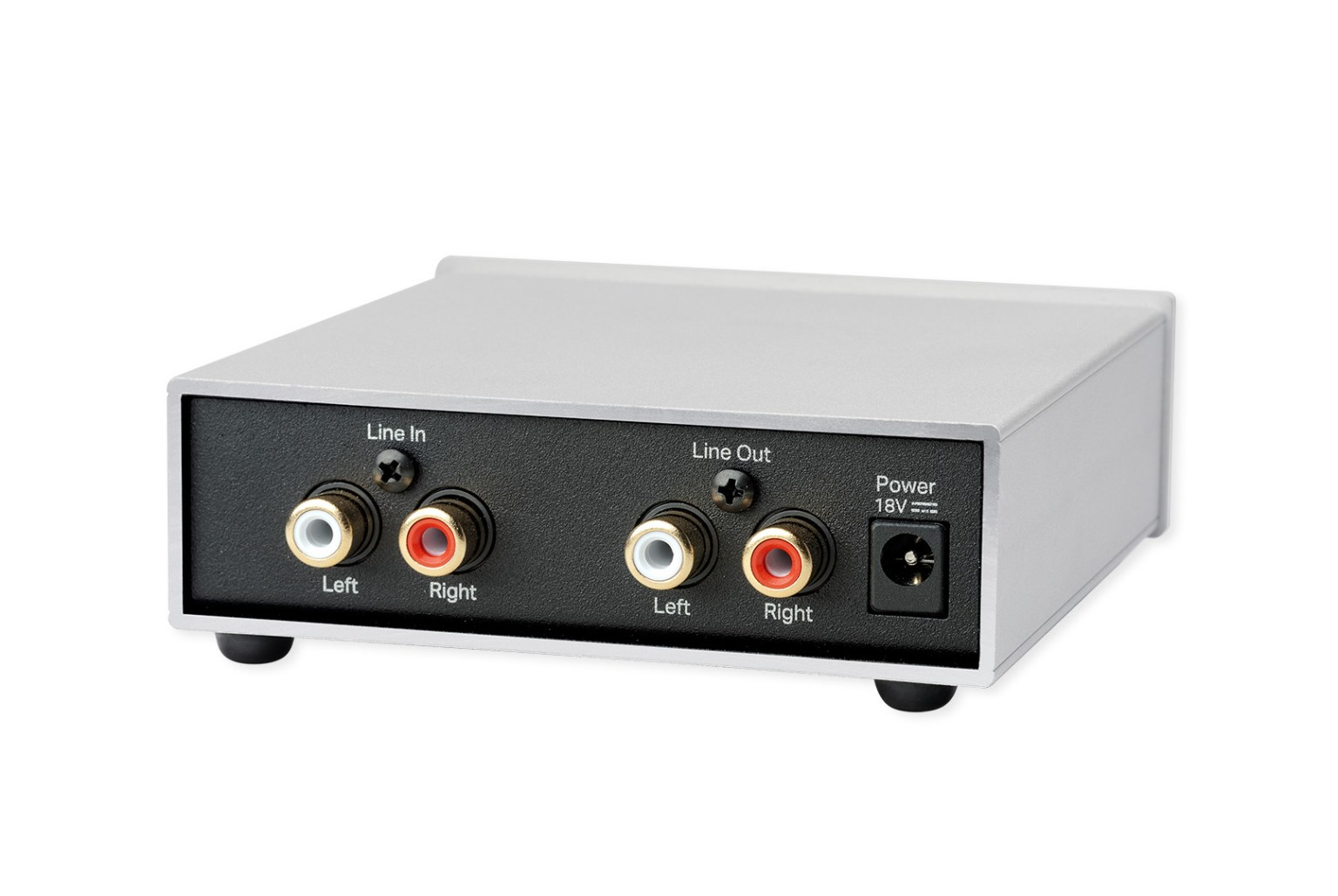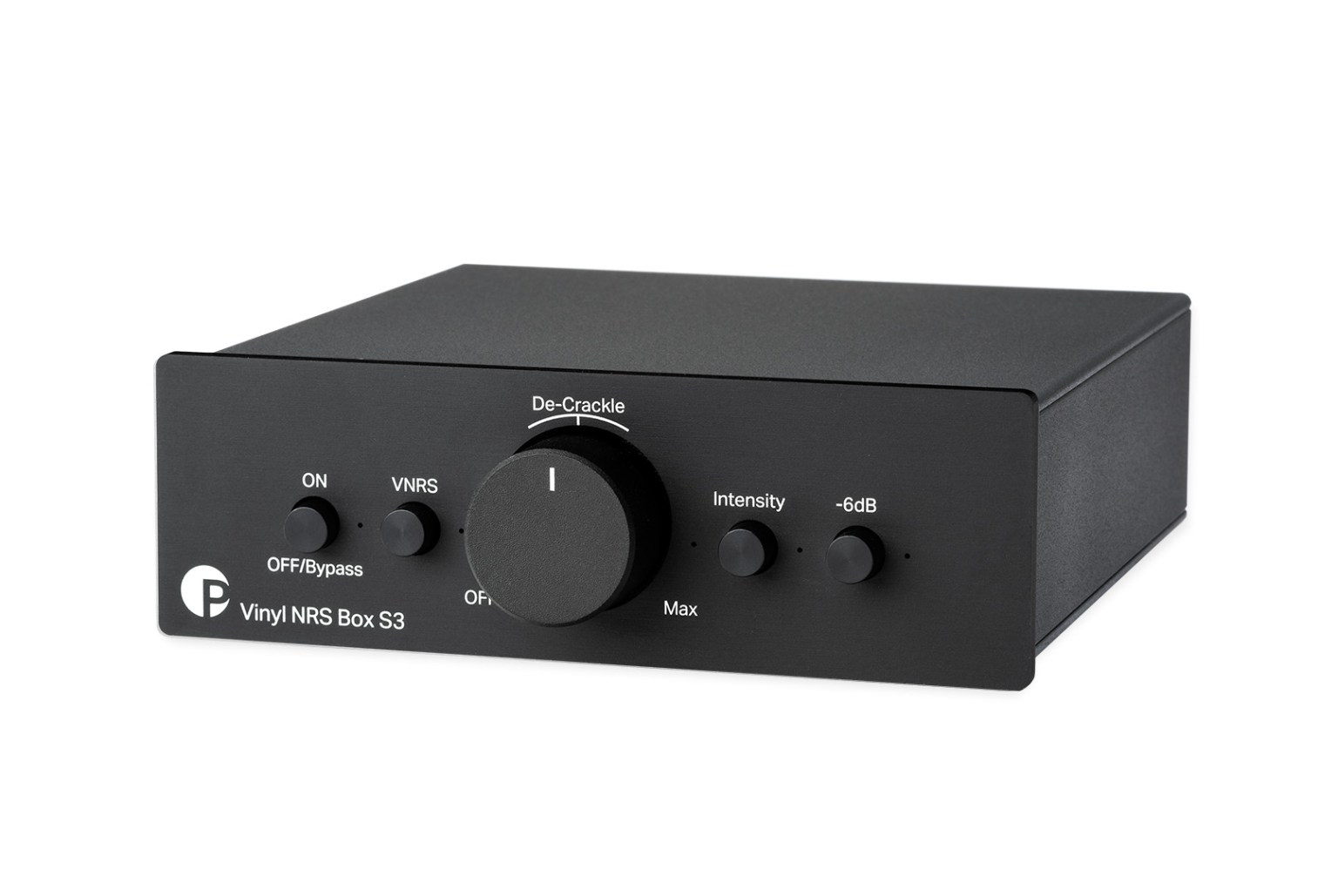Can Pro-Ject’s $399 Vinyl NRS Box S3 Effectively Reduce Surface Noise?
The most affordable real-time vinyl noise reduction system yet
In 2016, a company called Sweet Vinyl introduced the SugarCube SC-1 vinyl noise reduction system. Placed between a phono preamplifier and line preamp or integrated amp, the SugarCube digitizes the incoming signal at 192kHz/24bit, applies an adjustable real-time surface noise reduction algorithm, then outputs the cleaned-up signal. Though not for purists, the SugarCube made a good point: sure, you could digitally archive an especially noisy record, remove the annoying surface noise, and listen to the file, but then you lose the fun of actually playing the record. Digital noise reduction can easily be a disaster, yet according to Michael Fremer’s review, the SugarCube’s algorithm miraculously worked most of the time.
However, the original SugarCube cost $1999—money that could be spent replacing one’s noisiest records with quieter copies. The newer model with an improved algorithm, the SC-1 Mini, still costs $1500. Then last year, Pro-Ject released the Vinyl NRS Box S3, a similar product for a more attainable $399. Is it a viable option for those on a tighter budget?
Features
The Vinyl NRS Box S3 is a neat, intuitively designed unit small enough to sit atop my Rega NEO power supply unit and only take up half its surface area. If heat isn’t an issue, you could also set it on top of small phono preamps. The NRS Box’s leftmost on/off switch engages or fully bypasses the unit. The next button, marked “VNRS,” activates a pop and click reduction algorithm that the manual says “can reduce vinyl surface noise and turntable drive noise up to 6dB [the website says 8dB], while played music stays practically untouched.” It separates the signal into two frequency bands then two expanders, supposedly to increase the signal-to-noise ratio.
 The large “De-Crackle” knob in the center adjusts the threshold for the de-crackle algorithm: all the way left is off, all the way right is the 8dB highest sensitivity. Pro-Ject recommends starting in the center. An “Intensity” switch will increase the algorithm’s strength, and finally there’s a -6dB switch, which to avoid clipping reduces the line level input signal by 6dB. Digitization is at 96kHz/24bit, which for this purpose is sufficient “enough.” Setup is easy: plug your phono preamp’s line level RCA output into the NRS Box’s input, and connect the NRS’ output to your line preamp/integrated amp.
The large “De-Crackle” knob in the center adjusts the threshold for the de-crackle algorithm: all the way left is off, all the way right is the 8dB highest sensitivity. Pro-Ject recommends starting in the center. An “Intensity” switch will increase the algorithm’s strength, and finally there’s a -6dB switch, which to avoid clipping reduces the line level input signal by 6dB. Digitization is at 96kHz/24bit, which for this purpose is sufficient “enough.” Setup is easy: plug your phono preamp’s line level RCA output into the NRS Box’s input, and connect the NRS’ output to your line preamp/integrated amp.
Listening
First, I played a Columbia six-eye stereo Kind Of Blue (CS 8163) that I scored for $10 in “good plus” condition. A sensitive and highly familiar recording with all sorts of surface noise (but no skips), for the NRS box it was the perfect extreme test. Right away, there were problems. Flicking between a full bypass and the NRS’ highest setting, I noticed virtually no difference in surface noise, other than a select few pops being softened but by no means “reduced,” much less removed. The persistent background crackle was still present, but more prevalent was the NRS’ sonic damage.
Digitization will inevitably at least somewhat reduce the quality. If the noise reduction algorithm is good, though, it’s only a small price to pay for a smoother listening experience. In theory, the Vinyl NRS Box S3’s 96kHz/24bit resolution is fine. Unfortunately, the algorithm seems primitive, and the digitization degrades the music well beyond what I expected or hoped. On Kind Of Blue, the instruments became harsh and grating in a boring, one-dimensional space. The algorithm is particularly bad at distinguishing high-frequency transients, especially cymbals, from surface noise; in that, it feels more like a compressor than a reduction unit. With the NRS’ controls all at their highest setting, the ride cymbal at the beginning of “So What” turned crunchy and kept breaking up. Horn texture was gone, and the bass also became annoyingly flat.
I then thought that I should be more forgiving to the NRS Box—after all, Kind Of Blue is a stupendous recording that blows most other records out of the water. I pulled out an original UK pressing of The Style Council’s Confessions Of A Pop Group (Polydor TSCLP5 / 835 785-1)—a Sony 3324 digital recording cut DMM, possibly with another digital step in the LP cut—which had light surface noise on the first side. It’s not a great sounding record in general, but works as a time capsule of 1980s studio technology. Once again, on the opener “It’s A Very Deep Sea,” the NRS Box with only the “VNRS” button engaged (no de-crackle) distorted the cymbals and harshly emphasized the somewhat blocky piano and thin vocal sound. Testing the “VNRS” pop reduction, I put on an original stereo copy of Sonny Rollins’ East Broadway Run Down (Impulse AS-9121), which has a deep, thin scratch through side A. The consistent pop was still too obvious, and just like the Kind Of Blue test, the texture was sucked out.
How much of this comes from the algorithm(s) versus the digitization? I ran a couple tests for that. With only the digitization turned on, I played a quiet EU clear vinyl pressing of The 1975’s I like it when you sleep… (Dirty Hit DH00118 / Polydor 4769130), a heavily but appropriately compressed recording. Similar to that Style Council record, the loss from the NRS highlighted dynamic and textural detail on a record that I thought didn’t have much. For instance, the electronic snare drum on “Somebody Else” became completely dull and annoying, and the vocals weren’t as present as they should’ve been. Engaging the milder “VNRS” again, I listened to “All I Want” from Joni Mitchell’s Blue (Reprise MS 2038). My original US copy has three pops on that song, which the NRS merely muffled. Worse, it turned the recording’s sparkling transients into flattened cardboard. High-resolution digital has gotten incredible, but this is not a shining example of it.
When using the NRS, I only had to engage the -6dB setting on the loudest 12” singles. Even then, you can leave it turned off and there’s only minor input clipping that most listeners wouldn’t notice.
The analog full bypass sounds fine. I could tell that there was an extra obstruction in my signal path, but there was no tonal difference. My system sounded about 95% as good as it does without the bypassed NRS and an extra set of interconnects.
Conclusion
As a longtime vinyl listener, some light surface noise on an older record doesn’t bother me, though for severely noisy records I understand the appeal of a real-time noise reduction system. Pro-Ject makes a wide range of generally great products at many price points, and I sincerely hoped that the Vinyl NRS Box S3 would live up to their usual standard. Even after adequate break-in time, however, the digitization is really not good and the noise reduction algorithms barely work. It’d be a different story if the lackluster digitization also meant that the reduction algorithms actually reduced noise. As it stands, though, I unfortunately can’t recommend the Vinyl NRS Box S3, even for $399.
Specifications
Internal sampling: | 96 kHz/24 bits |
Internal processing: | 56-bit accumulator, double precision |
Frequency response 20Hz to 20 kHz: | -0,6 dB / +0,1dB |
Frequency response 30Hz to 20 kHz: | -0,2 dB / +0,1dB |
Clip indication: | -0,6 dB below real clipping |
Bypass mode: | galvanic linked together (Rlink<0,3 ohm) |
THD: | <0,009% (500 mVrms Input Level) |
VNRS noise/rumble reduce: | up to 8dB (20Hz to 20 kHz) |
De-Click reduce (basic): | 8 dB (3kHz to 20 kHz) |
De-Click reduce (intensity): | 12 dB (2kHz to 20 kHz) |
Outboard power supply: | 18V/500mA DC, suitable for your country's mains supply |
Power consumption in standby: | 0W OFF/Standby, 2.2W ON (without outboard power supply) |
Dimensions: WxHxD (D with sockets): | 103 x 37 x 104 (119) mm |
Weight: | 340 g without power supply |
Manufacturer Information
Pro-Ject Audio Systems
Wirtschaftspark A5
Analogweg 1
2130 Mistelbach
Austria
Fine Sounds Americas (Sumiko Audio)
11763 95th Ave N
Maple Grove, MN 55369


















































